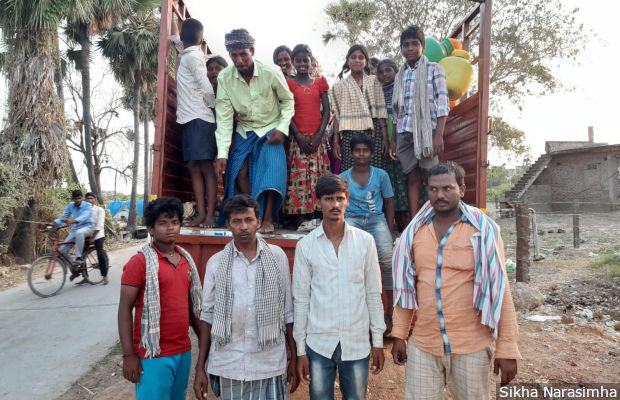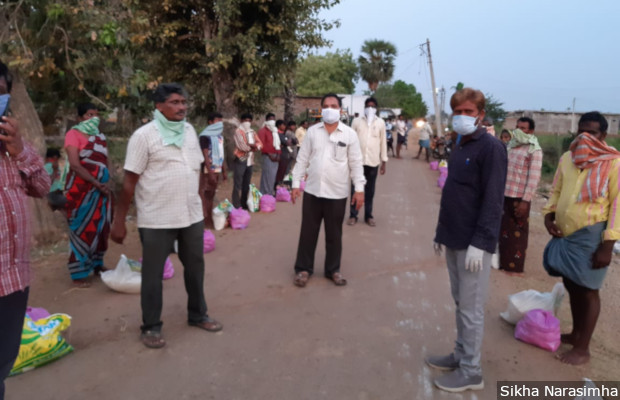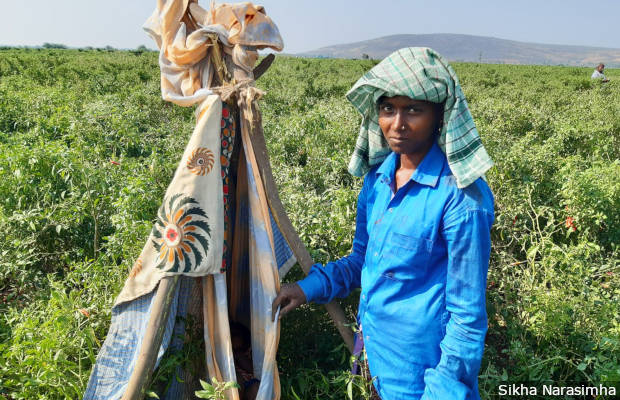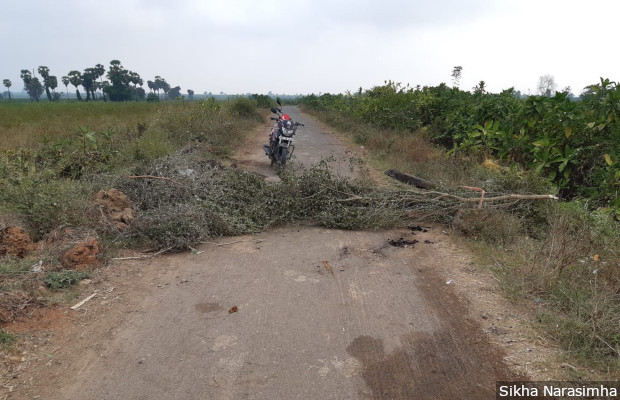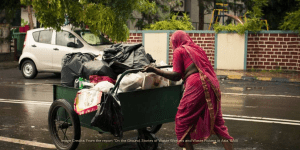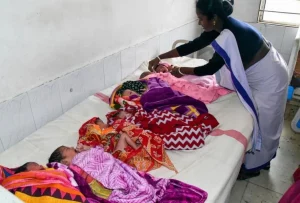COVID-19: Intra-State Migrants Marooned Too
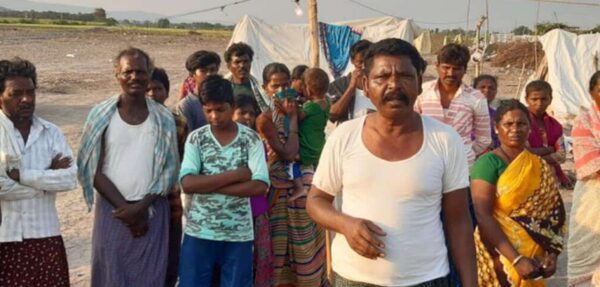
Seasonal farm workers from Mantralayam in Kurnool district, Andhra Pradesh (AP), stranded in a chilli farm in Peddapalem in the state’s Guntur district. Thousands of intra-state migrants from other districts in AP who work as seasonal farm labour are stranded in their workplaces with little or no support from the government.
Thousands of families of intra-state migrants are stranded on the margins of Guntur’s world-renowned chilli farms, scrambling to live on a meagre supply of grains and other provisions, and sheltering from 40 degree Celsius temperatures under tarpaulin, as they wait for the lockdown to end.
The continuing ordeal of these chilli-farm workers–hailing mostly from Andhra Pradesh’s drought-ravaged Kurnool district–who have neither been accommodated in buildings nor received timely rations and cash from the district administration, suggests that poor migrants within states may be even worse off during the lockdown than inter-state migrants whose home states have been taking up their plight with the states where they are marooned.
The national lockdown to contain COVID-19, announced by the central government with four hours’ notice on the evening of March 24, 2020, triggered massive reverse migration, with millions of migrants trying to return to their home states, and intra-state migrants also trying to return to their home districts, triggering concerns of contagion spreading to rural areas through these returning migrants. As borders between states, and even between districts within states, were sealed, millions remained trapped in their workplaces, including intra-state migrants, no reliable estimates of whose numbers are available.
Even in a pandemic, intra-state migrants appear to be invisible. While the Andhra Pradesh government issued detailed instructions on April 4, 2020, regarding inter-state migrants, saying “no person belonging to other state stranded in Andhra Pradesh should complain about non-availability of food and other basic amenities”, it had little to say on intra-state migrants, beyond stating that they should be allowed to get rations using portability in electronic-Public Distribution System. Even these rations have not reached many of the intra-state farm workers in the district, according to voluntary groups in Guntur.
Chilli pickers stopped halfway home
Husseni (he uses only one name) was in a group of 70 who were stopped by police on March 27, 2020, while travelling in a hired open truck from the chilli farm where they worked to their homes in Alavam village in Kurnool’s Kosigi mandal (block). They were halfway home in the roughly 320-km journey southwest, when they were ordered to turn back.
After returning to the farm in Peddapalem, the group of men, women and children sat with their belongings for two days under the open sky without food or water. “Our kids have turned pale with hunger, but no one is bothering about us,” Husseni told IndiaSpend in a phone interview on the morning of March 29, 2020.
A group of seasonal farm hands who work on Guntur’s chilli farms. On March 27, 2020, over 3,000 migrant workers headed home to Kurnool by hiring trucks for Rs 30,000 were turned back to their farms by the police at the district border due to the COVID-19 lockdown.
The seasonal migrants, though anxious to get home on account of COVID-19 and the lockdown announced by the Andhra Pradesh government from March 23 to March 31, 2020 (extended to April 14, 2020, as part of the national lockdown), were due to leave anyway. Their work had ended, and the tents housing them had been dismantled.
Each worker having earned Rs 350 a day during the three-month season that began in January 2020, they were not destitute. But their food had run out, and villagers did not allow them into local shops, fearing they had been infected with COVID-19 during their attempt to go home.
“I am so hungry, but they are not even allowing us to buy a packet of biscuits,” said eight-year-old Najma (uses only one name), weeping.
“They have threatened to drive us out of the farm if anyone tests positive in the village,” Venkanna (uses only one name), another worker, told IndiaSpend.
Later that afternoon, after a local NGO arranged dry rations, the farm workers were able to feed themselves and their children. The farmer whose chilli farm they worked on arranged tattered tarpaulin sheets to erect makeshift tents.
Several thousand stranded
Several thousand seasonal migrants, about half of them women and children, may be stranded in Guntur, farmers’ rights activists suggest. On just the evening of March 27, 2020, about 3,000 migrant workers heading home in open trucks were turned back at the border between Guntur and Prakasam districts, which they would have had to cross to reach their homes in Kurnool.
Atchampeta, one of Guntur’s 58 mandals (blocks), had 6,846 seasonal farm workers–around 3,200 from Kurnool–according to data collected by the state government for relief purposes. Data for other mandals are not yet available, revealing poor record-keeping on seasonal migrants, who have been coming to this prosperous district for two decades from arid western Andhra Pradesh.
Volunteers from local NGOs distributing food and sanitation items to stranded migrant workers on Guntur’s chilli farms. As the state of AP sets up relief mechanisms for inter-state migrants, intra-state migrants continue to rely on local NGOs for food.
Andhra Pradesh began distributing free rations–5 kg rice and 1 kg dal per family–on March 29, 2020, as part of the welfare measures it announced during the lockdown, but this is yet to reach many of the seasonal migrants. Even among groups that have received these rations, those without ration cards have been left out, say local volunteers who are feeding about 500 families.
“We left our ration cards at home in Kurnool for our family there. Now we have been asked to wait for a few more days to get the free rice and dal promised by the Jagan government,” Venkanna told IndiaSpend, referring to chief minister Y S Jagan Mohan Reddy.
“In normal times, those living in villages have always received rations distributed by the state before workers living on farms,” said Sikha Narasimha, who runs LEAF, a local NGO that has been distributing food. “We have been appealing to the district administration to at least prioritise these migrant workers on farms during the pandemic, because they are completely without supplies.”
The chilli pickers have also not been given the Rs 1,000 per family promised by the state government during the lockdown. They have been told they would get this only when they return to their villages.
‘Our kids will die of heatstroke’
While the district administration maintains it is working towards delivering rations to all migrants, it has been silent on the question of providing shelter. When asked, twice, about plans for proper shelters for the migrant workers, the district collector of Guntur, I. Samuel Anand Kumar, told IndiaSpend that it had been arranged. However, NGOs and the farm workers themselves said this was not the case.
“If not hunger, heatstroke will kill us and our children,” said Easweramma, alluding to the soaring temperatures. Besides, there is a severe lack of privacy, water and sanitation facilities, making life especially difficult for women.
A young mother uses a makeshift cradle with sarees and sticks to shield her child from the heat in Peddapalem in Andhra Pradesh’s Guntur district. As temperatures soar above 40 degrees Celsius, the state is silent on providing shelter to migrant workers who live on open farms, and people are having to improvise to save their lives.
Narasimha said he had asked the mandal revenue officer to house the chilli farm workers in empty schools, but was told “village people will not allow them to stay there for fear of contracting coronavirus from them”.
“During the day, they sit under trees for shade, mothers protecting small babies from the heat by keeping them in makeshift cradles made with sticks and sarees,” he said.
They also have to worry about being evicted once farmers begin to prepare their fields for the kharif (monsoon) crop. In a farm in Neeleswarapalem village in Atchampeta mandal, a group of seasonal workers was asked to vacate a farm for this reason. Local officials had to persuade the farmer to let the group stay.
IndiaSpend has written to the state nodal officer in charge of humanitarian aid during the pandemic, and the district nodal officer for Guntur district, asking about shelter arrangements for migrant workers. This report will be updated with their responses.
Kerala and Telangana ahead of AP
Like most Indian states, Andhra Pradesh was slow to respond to the crisis of migrant workers stranded in the state, activists say.
“AP was no different from any state, except Kerala, in imagining how a lockdown would affect the most marginalised,” said Kavitha Kuruganti, farmers’ rights activist and a convenor of the Alliance for Sustainable and Holistic Agriculture. “Governments are showing how apathetic they can be unless they are alerted, harangued, pursued and prodded.” Kuruganti has been leading migrant relief work and coordinating with senior bureaucrats in Andhra Pradesh and Telangana to mitigate the distress of stranded migrants.
By March 27, 2020, Kerala had already opened 4,603 relief camps to house 144,145 migrant labourers, referring to them as ‘guest workers’. In contrast, Andhra Pradesh’s chief secretary issued orders to identify stranded migrant workers, arrange shelters for them, and provide them with food, drinking water and sanitisers, on March 29, 2020, a week after its lockdown was announced.
Even after these belated instructions, relief work at the district level was uneven, and at the discretion of district collectors, activists say. Neighbouring Telangana, which announced free rations and Rs 500 cash relief for each of the 335,669 migrant workers enumerated by the state on March 29, 2020, performed better, they point out.
Furthermore, on April 4, 2020, the Andhra Pradesh government, as we said, directed the district to make arrangements for food and shelter for migrant workers from other states along with homeless people and beggars, but had little to say about stranded migrants from within the state.
“This crisis has revealed two things–one, that the state has no place for intra-state seasonal migrant labour in its imagination. Second, the much touted systems like biometrics are a failure,” Kuruganti said, referring to the migrants’ inability to access rations.
Lack of credible information
Lack of credible information about the pandemic and lockdown has worsened the trauma of the seasonal workers living and working in relative isolation on the chilli farms. They did not get their news from television or smart phones, but from relatives they spoke to on their basic phones. The state’s lack of communication on how it was going to enforce its lockdown, and the suddenness of the national lockdown, added to their bewilderment.
“We were told about the Janata Curfew on March 22, 2020, and we observed it properly. No one told us that we would not be able to travel after that,” Husseni said.
Groups that had left before March 27, 2020, had not been turned back at the district’s border, so the migrants who left that day were shocked to experience this. “We paid Rs 30,000 to hire a truck to take us home. The transporter refused to give us back our money when we had to turn back,” said Anjanamma (uses only one name), one of the workers.
Even worse is the ostracisation faced by the farm workers, who make a significant contribution to Guntur’s status as a hub of the international chilli trade. Barricades have been put up not just between villages but even between streets within the villages, to impede the free movement of anyone the villagers perceive as an ‘outsider’.
An improvised barricade in a village near Atchampeta to prevent ‘outsiders’ from coming in. In the last few weeks, such barricades–known as ‘social fencing’ locally–have come up between villages and even between streets in a village.
“Rural India is grappling with rumours and
prejudices without a clear understanding of what the pandemic is about,” said Kuruganti. “It’s not that hard for the government to run an awareness campaign about the pandemic and to assure migrant workers it is there for them.”
“We do know that staying back is the best option for us right now. But not once has the government told us, ‘We will take care of you’,” said Husseni.
Migrants worry about those at home
Successive droughts over 15 years in Rayalaseema, the arid western region of Andhra Pradesh consisting of the four districts of Kurnool, Anantapur, YSR Kadapa and Chittoor, have forced farmers to turn to daily wage labour, as IndiaSpend reported in April 2019. Between 2014 and 2018, continuous drought has impacted close to 3.2 million farmers resulting in losses of upto Rs 3,216 crore ($509 million), according to the latest available data.
Recurring droughts and depleting groundwater resources have forced not just landless, small farmers and marginal farmers but big landowners, too, to give up agriculture and migrate to prosperous places for daily-wage jobs in agriculture or construction, both within and outside the state.
In the absence of official estimates, farmers’ rights activists say that 60,000 to 100,000 people from Kurnool come to work annually on Guntur’s chilli farms, about 30 to 70 people per farm. Between January and April, they earn just about enough to tide them through the rest of the year. Some bring their children with them, to help with chilli picking and boost their earnings, while those better off leave their children behind with their elderly parents so that they can go to school.
“Our children and parents back home are worried about us,” said Easwaramma (uses only one name), another migrant worker from Kosigi stranded in Guntur. “They are crying and begging us to come home. We all want to be together in these difficult times.”
The growing number of positive cases in both Andhra Pradesh and Telangana have made families anxious about their relatives stuck in Guntur: The district has seen a rising number of COVID-19 cases with 33 positive cases, third highest after Kurnool (74) and Nellore (42), as of 11 a.m. on April 7, 2020.
Migrant workers who have left their children behind with elderly relatives are worried that they will go hungry in the absence of cooked mid-day meals due to school closures. Cooked school meals are often the only source of food for the children of seasonal migrants during the months that their parents are away, as we reported earlier.
“My old mother-in-law can barely see. What will she cook?” asked an anxious Anjaneyamma. “Neighbours are giving them food right now. But for how long? How can we be at peace when our kids are hungry?”
[This article was first published in Indiaspend]
We believe everyone deserves equal access to accurate news. Support from our readers enables us to keep our journalism open and free for everyone, all over the world.
